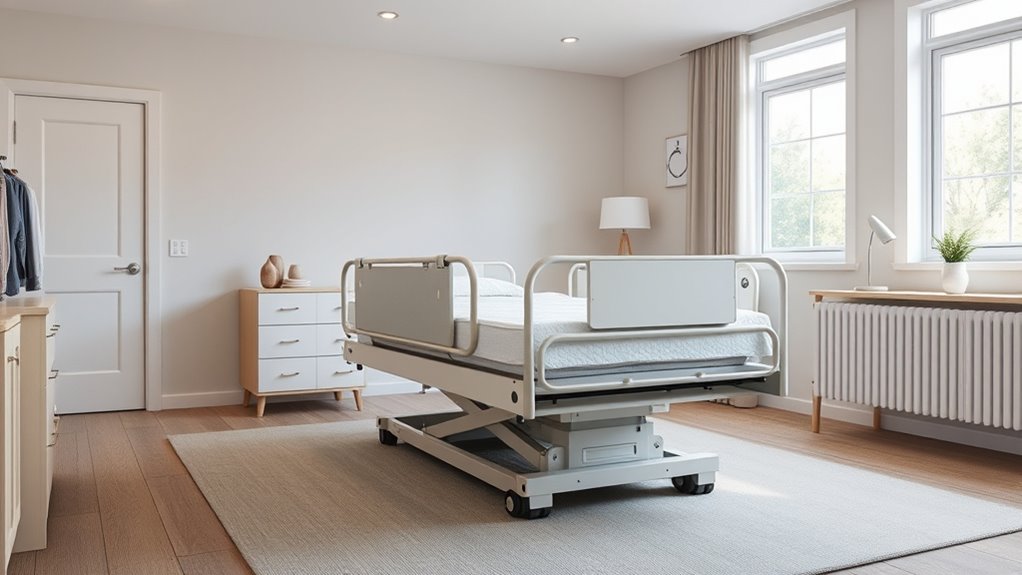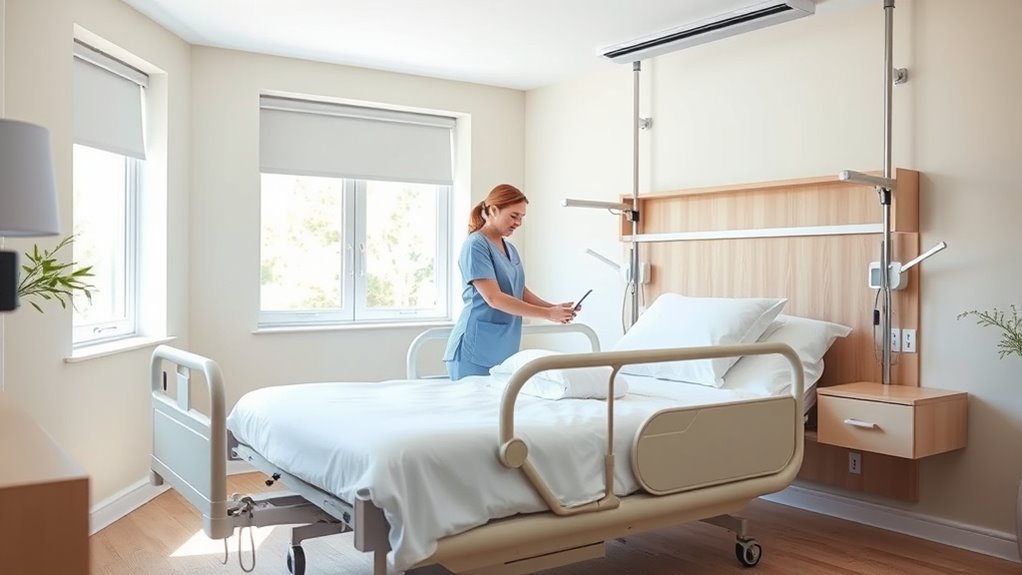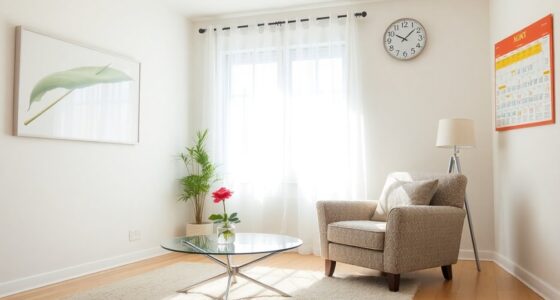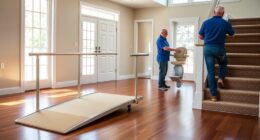To create a shift-ready bedroom, choose an adjustable hospital bed that fits well and is easy to control, ensuring safety and comfort. Properly install a lift or ceiling track system positioned for smooth transfers between bed and wheelchair. Make sure there’s at least 36 inches of clearance for caregivers to move safely and operate equipment comfortably. Thoughtful placement of furniture and transfer aids helps prevent obstructions. For more tips on making your space safe and adaptable, keep exploring the essentials.
Key Takeaways
- Position hospital beds and lifts to ensure smooth transfers with ample space for movement and caregiver access.
- Maintain a minimum of 36-inch pathways for safe navigation around furniture and equipment.
- Select adjustable beds and furniture to accommodate changing needs and facilitate easy transfers.
- Place transfer aids and controls within arm’s reach to enhance safety and independence.
- Arrange furniture to support seamless transitions, minimizing physical strain and maximizing safety for caregivers.

Creating a shift-ready bedroom means designing a space that easily adapts to changing needs, whether you’re preparing for a child’s growth or accommodating mobility requirements. When you think about making a room transition-ready, you’re focusing on flexibility and safety, guaranteeing that the space can serve different functions without requiring complete overhaul. One of the most important elements is planning for a hospital bed or adjustable sleep surface. These beds aren’t just for hospitals—they can be essential for home use, especially if someone has mobility challenges or health issues. Installing a hospital bed allows you to easily raise or lower the mattress for comfort and safety, reducing strain on caregivers and minimizing the risk of falls. It’s vital to select models that fit seamlessly into the bedroom, with accessible controls and enough clearance for mobility aids like wheelchairs or walkers.
Alongside a hospital bed, you should consider the placement of lifts or transfer aids. Patient lifts or ceiling track systems can markedly ease the transfer process for both the caregiver and the individual. Proper placement ensures that the lift can move smoothly from bed to wheelchair or other seating, without obstruction. You want to position furniture and equipment thoughtfully, leaving enough space so that movement is unimpeded. This not only improves safety but also enhances independence by making transfers less physically demanding. When installing lifts, always follow manufacturer guidelines and guarantee that the weight capacity and clearance are appropriate for your specific needs.
Caregiver clearance is another vital factor. As you design a transition-ready bedroom, make sure there’s enough room for caregivers to operate equipment comfortably and safely. Clear pathways should be maintained, ideally at least 36 inches wide, to allow easy movement and reduce the risk of accidents. Keep essential items within arm’s reach, such as emergency call buttons, lighting controls, and frequently used supplies, so caregivers don’t have to stretch or reach awkwardly. Additionally, consider adjustable furniture options, like height-adjustable beds and chairs, to accommodate different caregivers’ heights and preferences, making caregiving less strenuous.
Frequently Asked Questions
How Do I Choose the Right Hospital Bed Size for My Space?
You choose the right hospital bed size by measuring your space first. Make certain there’s enough room for the bed, plus clearance for movement and accessories. Consider the patient’s size and comfort—standard beds are usually 36 inches wide, but wider options exist for extra space. Check doorways and hallways to make sure the bed fits comfortably without blocking pathways. Prioritize safety, functionality, and room for caregiver access.
What Safety Features Are Essential for a Transition-Ready Bedroom?
A stitch in time saves nine, so prioritize safety features to create a secure change-ready bedroom. You should guarantee the bed has side rails to prevent falls, adjustable height for easy access, and sturdy frames for support. Install slip-resistant flooring and good lighting to prevent accidents. Keep emergency call systems nearby, and make sure pathways are clear of obstructions. These features help promote safety and independence during your transition.
How Often Should Caregiver Clearance Assessments Be Updated?
You should update caregiver clearance assessments at least annually, or more frequently if the patient’s condition changes. Regular updates guarantee caregivers remain fit to provide safe care and identify any training needs. Keep an eye on any health or mobility shifts that might affect their ability. Consistent reassessment helps maintain a safe environment and ensures that both caregivers and patients are protected, fostering ongoing safety and confidence.
Can Existing Bedrooms Be Easily Modified for Transition Readiness?
Yes, existing bedrooms can be easily modified for change readiness. You can adjust furniture placement, install grab bars, and widen doorways to improve accessibility. Consider replacing standard beds with hospital-style beds and adding lifts or ramps where needed. With some strategic changes, you create a safer, more functional space that meets your needs, making the transition smoother and more comfortable for everyone involved.
What Are the Cost Considerations for Converting a Bedroom?
A stitch in time saves nine, so considering costs early helps you avoid surprises later. Converting a bedroom involves expenses for equipment like hospital beds and lifts, plus potential modifications to walls or flooring. You’ll also need to budget for professional assessments, installation, and ongoing maintenance. While costs vary, planning carefully guarantees you get the right setup without overspending, making your space both functional and safe for your loved ones.
Conclusion
By ensuring your bedroom is conversion-ready, you create a safe, comfortable space for your loved one’s journey ahead. With the right hospital bed, lift, and caregiver clearance, you’re setting the stage for smoother days and nights. Think of it like having your own personal JARVIS—ready before the Bat-Signal even shines. Take action now, and turn your bedroom into a fortress of safety, because a well-prepared space makes all the difference in the world.









